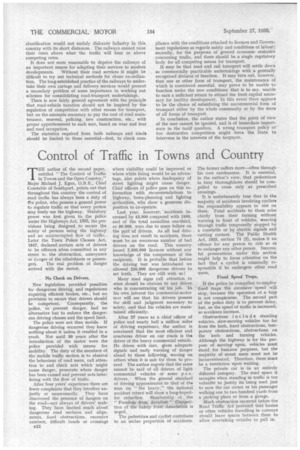Control of Traffic in Towns and Country
Page 32

If you've noticed an error in this article please click here to report it so we can fix it.
THE author of the second paper. entitled "The Control of Traffic in Towns and the Open Country," Major Michael J. Egan, 0.B.E., Chief Constable of Southport, points out that throughout this country the control of road traffic has always been a duty of rile police, who possess a general power to regulate traffic so that every person may freely use the highway. Statutory power was first given to the police under the Highways Act, 1835, the provisions being designed to secure the safety of persons using the highway and an uninterrupted flow of traffic. Later the Town Police Clauses Act, 1847, declared :certain acts of drivers to be offences when committed in any street to the obstruction, annoyance or danger. of the inhabitants or passen
gers. The real problem of danger arrived with the motor.
No Check on Drivers.
New legislation provided penalties for dangerous driving, and regulations requiring efficient brakes, etc., but no provision.to secure that drivers should be competent. Consequently, the police, to prevent danger, had no alternative but to enforce the dangerous driving clauses and the speed limit.
The police were not then mobile. If dangerous driving occurred they knew nothing about it unless it resulted in a crash. Not until 30 years after the introduction of the motor were the police provided with means for mobility. The duty of the members of the mobile traffic section is to observe the behaviour of road users, call attention to and check acts which might cause danger, prosecute where danger has been caused and prevent acts interfering with the flow of traffic.
After-four years' experience there are fewer complaints that they interfere unjustly or unnecessarily. They have discovered the presence of dangers on the road—not always of drivers' making. They 'have learned much about dangerous road surfaces and alignments, fixed obstructions, excessive cambers, difficult bends or crossings
B22 where visibility could be improved or where white lining would be an advantage, also points where inadequacy of street lighting might cause danger. Chief officers of police pass on this information with recommendations to highway, 'town-planning and lighting authorities, who show a generous disposition to co-operate.
Last year, however, accidents increased by 43,000 compared with 1930, and of the total casualties one-third, or 80,000, were due to some failure on the part of drivers. As all bad driving does not result in accidents, there must be. an enormous number of bad drivers on the road. This country issued 2,500,000 licences without any knowledge of the competence of the recipients. It is probable that before the driving test was introduced we allowed 250,000 dangerous drivers to set forth. They are still with us Many road signs call attention to what should be obvious to any driver who is concentrating on his job. In his own interest the commercial-motor usar will see that his drivers possess the skill and judgment necessary to safety, and that his vehicles are maintained efficiently.
After 27 years as a chief officer of police and nearly half a million miles of driving experience, the author is convinced that the most efficient and courteous driver on our roads is the driver of the heavy commercial vehicle. He drives with care, gives adequate signals and early warning of danger ahead to those following, waving on others when it is safe for them to proceed. The author regrets that the same cannot be said of. all drivers of light commercial vehicles or some p.s.v. drivers. When the general standard of driving approximates to that of the man on "the heavy," the national accident return will show a long-hopedfor reduction. Membership of the " Freedom from Accident" Competition of the Safety First Association is urged.
The pedestrian and cyclist contribute to an undue proportion of accidents. The former suffers more—often through his own carelessness. It is essential, in the author's view, that pedestrians in busy thoroughfares should be compelled to cross only at prescribed crossings.
It is unfortunately true that in the majority of accidents involving cyclists the responsibility appears to rest on them. Fatal accidents to them arise chiefly from their turning without warning in front of vehicles, weaving throu.gh traffic temporarily stopped by a constable or by electric signals and cutting corners. The Public Health Act, 1925, section 74 (2), makes it an offence for any person to ride so as to endanger any other person. Successful prosecutions under this section might help to focus attention on the fact that a cyclist is criminally responsible if he endangers other road users.
Fixed Speed Traps.
If the police be compelled to-employ fixed' traps the excessive speed will stop, because the operation of a trap is not conspicuous. The second part of the police duty is to prevent delay, but, as the speed of traffic is increased, so accidents increase.
Obstructions include standing vehicles, slow-moving vehicles too far from the kerb, fixed obstructions, temporary obstructions, obstructions on the kerb and turning vehicles. Although the highway is for the purpose of movingupon, vehicles must stand for business purposes, but the majority of street users must not be inconvenienced. Therefore, there must be a restriction upon waiting. •
The private car is in an entirely different category. The roadspace it occupies When standing in traffic is too valuable to justify its being used just to save the car owner or his passenger walking one to two hundred yards from a parking place or from a garage.
Much obstruction occurred before the Road Traffic Act' provided that lorries or other vehicles travelling in convoys should leave spaces between them to allow overtaking vehicles to pull in.




















































































